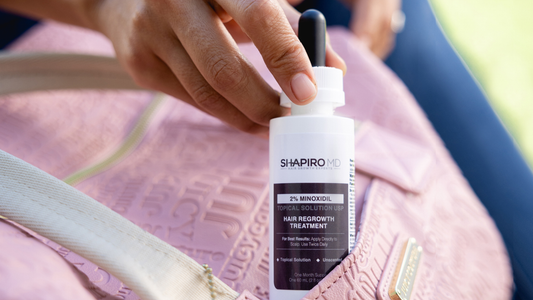Chances are your hair loss has nothing to do with anything you’re doing wrong – or not doing right, for that matter – and everything to do with your genetics. For both men and women, hair loss that is not the result of stress or environmental factors but a result of genetics is generally considered androgenic alopecia.
If you're a man or a woman dealing with hair loss from androgenic alopecia, take solace in the fact that there are solutions, and you may be able to fight future thinning and support hair growth with natural ingredients like saw palmetto.
Thanks to innovations in the hair industry, there are now several treatments available for hair loss for both men and women. Toupees have long been used by men to hide patches of hair loss on the crown of the head, while extensions have gained popularity as a hair thinning fix for women. Wigs, of course, are a traditional solution and have regained popularity thanks to celebrities such as Kim K. However, toupees, extensions and wigs are just temporary solutions; many hair-loss sufferers want a more permanent fix.
Topical solutions and oral medications that prevent and even reverse hair loss have been around since the ‘90s, though there has been little real innovation from the pharmaceutical industry since then. Surgical measures such as hair plugs have also proven to be effective; however, surgery can be prohibitively expensive, and for the average consumer who has androgenic alopecia surgery isn’t a viable option.
What Is Saw Palmetto, and Is it Effective For Hair Loss?
Saw palmetto is a plant that’s been used by Native tribes as an herbal remedy for infections, weight management, and hair loss for hundreds of years. A closer look at the science indicates why it’s been used for so long.
According to researchers and dermatologists, DHT (dihydrotestosterone) is the hormone believed primarily responsible for hair loss. In people with androgenic alopecia, DHT impacts their hair follicles such that they shrink and produce thinner, weaker, and shorter hairs. These DHT-damaged follicles also stay dormant for longer periods of time.
Saw palmetto contains an active ingredient that can block the enzyme responsible for converting testosterone into dihydrotestosterone (DHT). Similarly, the only oral drug available and approved by the U.S. FDA to treat hair loss in men (and help regrow their hair) is called finasteride, and it too works by reducing how much DHT is in the body.
Reducing DHT at the scalp and hair follicles can help fight hair loss in men and women with androgenic alopecia.
While native peoples didn’t know why it was working two hundreds years ago, they recognized that saw palmetto was doing something to stop hair loss.
Saw palmetto appears to have the same mechanism to fight DHT; it’s similar to the active ingredient found in the prescription hair loss medication finasteride.
Though research is limited on the efficacy of saw palmetto as a hair loss treatment, and it’s never been brought before the U.S. FDA, studies that have been conducted on saw palmetto in hair loss have yielded seriously promising results.
According to one study, half of the participants with androgenic alopecia who were treated with topical saw palmetto increased their hair count by 11.9 percent over the course of four months.
Other research has backed up the claims for saw palmetto in hair loss: “Five randomized clinical trials (RCTs) and 2 prospective cohort studies demonstrated positive effects of topical and oral supplements containing SP (100–320 mg) among patients with androgenetic alopecia (AGA) and telogen effluvium. Sixty percent improvement in overall hair quality, 27% improvement in total haircount, increased hair density in 83.3% of patients, and stabilized disease progression among 52% were noted with use of various topical and oral SP-containing supplements,” reads one paper published in 2020. Most importantly, saw palmetto was able to help block nuclear uptake of dihydrotestosterone (DHT) and decrease DHT binding capacity to androgen receptors.
The Different Forms of Saw Palmetto
Because saw palmetto is an ingredient found in nature, it can be easily extracted and re-manufactured into several different forms. You can find saw palmetto in the following forms:
- Whole dried berries
- Capsules
- Topical ointments and haircare solutions
- Liquid extracts
A mixture of topical treatments may prove to yield the best results. However, if you do opt to use saw palmetto as a hair loss treatment by eating or ingesting it, know that there is imperfect research on the ingredient and that you may or may not experience side effects. Some people opt to use the berries as a tea, but doing so may be ineffective. Saw palmetto is not water soluble, and while the berry may be a sufficient flavoring technique, you may not get any of the benefits of its active components. Capsules and topicals are the only two forms of saw palmetto that have been subject to any sort of scrutiny, and what researchers have found has been relatively positive. Because the herb is natural, it is considered to be safe.
While the research continues to develop on saw palmetto, the underlying mechanism aligns with what we know about androgenic alopecia and proper treatment.
Dr. Shapiro included saw palmetto as one of three key ingredients in Shapiro MD Shampoo and Conditioners because of its potency in fighting DHT and the potential for it to combat thinning at the scalp. Thousands of men and women have used these powerful topicals to fight the signs of aging and thinning, with healthier hair just by swapping out their normal shampoo and conditioner.
There are good reasons it’s still being used by thousands of men and women today to fight DHT and support proper hair health at the scalp.




